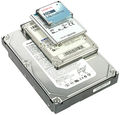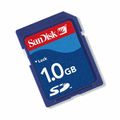Difference between revisions of "Laptop Evaluation Checklist"
m (speeling eroors) |
|||
| Line 1: | Line 1: | ||
| + | __NOTOC__ | ||
| + | ===1. Data security check=== | ||
| + | {{Template:Data Security for Builders}} | ||
| + | ---- | ||
| + | ===2. Physical Evaluation=== | ||
| + | ☐ Take a good look at the laptop you are evaluating. Start by looking for: <br> | ||
| + | *A floppy drive | ||
| + | *Missing cover plates from the back of the laptop | ||
| + | *Missing battery or optical drives | ||
| + | *Missing keyboard or keys | ||
| + | *Cracked case parts or broken hinges | ||
| + | *Damaged ports | ||
| + | *Visible screen damage | ||
| + | **This appears as hairline cracks or dark splatter-like marks inside the screen. | ||
| + | *Oxidation or evidence of liquid spills | ||
| + | ☐ Stop here and check with your instructor if you find anything from the list. They may have you follow the Recycling or As-Is Guide instead. | ||
| + | ---- | ||
| + | ===3. Find an appropriate AC adapter=== | ||
| + | {{Template:AC_Adapter}} | ||
| + | ---- | ||
| + | ===4. POST=== | ||
| + | ☐ Try turning the machine on. <br> | ||
| + | *If the system loads the BIOS splash screen, you can move to the next step. | ||
| + | *If the system does not boot, or appears to have video problems, use the [[Laptop POST Troubleshooting Guide]] in the Appendix. | ||
| + | ---- | ||
| + | ===5. Determine Specifications=== | ||
| + | ☐ Enter BIOS. | ||
| + | *Note the processor type and speed. | ||
| + | *Note the amount of RAM installed. | ||
| + | ☐ If processor and RAM information is not listed in BIOS, boot to the Free Geek network boot menu and use the Hardware Detection Tool. | ||
| + | *Instructions for how to access the network boot are in the Appendix, in the [[Laptop Network Boot]] guide if you need help. | ||
| + | ☐ Use the Laptop Build room whiteboard or the [[Laptop Specs]] sheet in your Appendix to determine which category the laptop falls in: High end, midgrade, low end, FG-PDX, or As-Is. | ||
| + | *We categorize Laptops by processor type. | ||
| + | *For As-Is machines, follow the [[As-Is Checklist]]. | ||
| + | ---- | ||
| + | ===6. Install Hardware=== | ||
| + | ☐ Install RAM depending on the spec guide. | ||
| + | ☐ Ask your instructor for an imaged hard drive. They may have you skip this step for now. | ||
| + | ---- | ||
| + | ===7. Keeper label=== | ||
| + | The Keeper label is used to: | ||
| + | *Keep track of basic hardware information. | ||
| + | *Track the laptop through RAM testing (called memtest), battery testing, and the build process. | ||
| + | *Transfer notes about the laptop from builder to builder, and the instructors. <br> | ||
| + | ☐ Fill out these fields:<br> | ||
| + | *Laptop make and model | ||
| + | *CPU type and speed | ||
| + | *RAM size and type | ||
| + | ---- | ||
| + | ===8. Begin Memtest86+=== | ||
| + | ☐ Put the laptop on the testing shelf paired with the AC adapter and start Memtest. Full instructions are in the [[Memtest for Builders]] guide in the Appendix. | ||
| + | ---- | ||
| + | [[Category:Laptops]] | ||
| + | |||
| + | |||
| + | |||
| + | |||
| + | |||
| + | |||
| + | |||
| + | |||
| + | |||
| + | |||
| + | |||
| + | |||
| + | <!-- Below is the old Eval checklist table. It can go away soon. Just leaving in the document for reference for now. | ||
| + | Lynnae G. 12/2012 | ||
| + | |||
| + | |||
| + | |||
| + | |||
{| border="1" fontsize="12" cellpadding="5" cellspacing="1" | {| border="1" fontsize="12" cellpadding="5" cellspacing="1" | ||
|- | |- | ||
| Line 52: | Line 123: | ||
You can either boot Memtest from the hard drive, the network, or a Live CD. For guidance, follow the steps under the [[Laptop Testing#Memtest|Laptop Testing]] guide. | You can either boot Memtest from the hard drive, the network, or a Live CD. For guidance, follow the steps under the [[Laptop Testing#Memtest|Laptop Testing]] guide. | ||
|} | |} | ||
| + | --> | ||
Revision as of 14:27, 8 December 2012
1. Data security check
We are responsible for securely wiping or destroying any storage device that is donated to Free Geek. This commonly means removing hard drives to be wiped, but keep an eye out for other kinds of data storage devices as well.
What to keep in mind when removing hard drives
☐ Make sure to separate any caddy parts and adapters from the hard drive.
☐ Tape any caddy parts, adapters, and screws together back inside the hard drive bay. These should stay with the system unless your instructor needs them for parts.
☐ Only ever leave hard drives and other storage devices in a designated box or with your instructor.
Check for disks and other storage media
☐ Check the optical drive for disks.
- Look for the small quick-release hole on the faceplate, and use a paperclip to manually open the drive.
☐ Take a quick look for other kinds of media, let your instructor know if you find anything.
Commonly encountered storage devices:
- 3.5" hard drives (Desktop size)
- 2.5" hard drives (Laptop size)
- Optical disks
Less commonly encountered storage devices:
- 1.8" and other odd-sized small form-factor hard drives
- Mini PCI or mini PCIe solid state drives
- Small media cards (SD, Compact Flash, etc)
- SIM cards
- Floppy disks
- PCMCIA (PC Card) hard drives
- Examples
2. Physical Evaluation
☐ Take a good look at the laptop you are evaluating. Start by looking for:
- A floppy drive
- Missing cover plates from the back of the laptop
- Missing battery or optical drives
- Missing keyboard or keys
- Cracked case parts or broken hinges
- Damaged ports
- Visible screen damage
- This appears as hairline cracks or dark splatter-like marks inside the screen.
- Oxidation or evidence of liquid spills
☐ Stop here and check with your instructor if you find anything from the list. They may have you follow the Recycling or As-Is Guide instead.
3. Find an appropriate AC adapter
Requirements
For an AC adapter to power the device correctly, it must:
- Match the input voltage (V) of the laptop exactly.
- Match or exceed the recommended amperage (A).
- Have a plug that fits into the laptop snugly and provides power.
☐ Find the input voltage and amperage listed on the laptop. This may be printed on the back of the laptop, or on the chassis under the battery.
☐ Find an AC adapter that matches the voltage and amperage listed on the laptop. You will be looking in the output section printed on the AC adapter, which should look like this:
INPUT: 100-240V~1.9A
50/60Hz
OUTPUT: 16V ⎓ 4.5A
Tip
AC adapters are sorted in bins by voltage, amperage, and brand; the bins are color-coded by brand.
4. POST
☐ Try turning the machine on.
- If the system loads the BIOS splash screen, you can move to the next step.
- If the system does not boot, or appears to have video problems, use the Laptop POST Troubleshooting Guide in the Appendix.
5. Determine Specifications
☐ Enter BIOS.
- Note the processor type and speed.
- Note the amount of RAM installed.
☐ If processor and RAM information is not listed in BIOS, boot to the Free Geek network boot menu and use the Hardware Detection Tool.
- Instructions for how to access the network boot are in the Appendix, in the Laptop Network Boot guide if you need help.
☐ Use the Laptop Build room whiteboard or the Laptop Specs sheet in your Appendix to determine which category the laptop falls in: High end, midgrade, low end, FG-PDX, or As-Is.
- We categorize Laptops by processor type.
- For As-Is machines, follow the As-Is Checklist.
6. Install Hardware
☐ Install RAM depending on the spec guide. ☐ Ask your instructor for an imaged hard drive. They may have you skip this step for now.
7. Keeper label
The Keeper label is used to:
- Keep track of basic hardware information.
- Track the laptop through RAM testing (called memtest), battery testing, and the build process.
- Transfer notes about the laptop from builder to builder, and the instructors.
☐ Fill out these fields:
- Laptop make and model
- CPU type and speed
- RAM size and type
8. Begin Memtest86+
☐ Put the laptop on the testing shelf paired with the AC adapter and start Memtest. Full instructions are in the Memtest for Builders guide in the Appendix.



